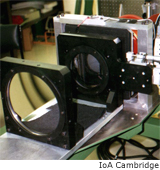Professor

Daniel Jaffe

Office: RLM 17.220
Hours:
Phone: (512) 471-3425
email

TA

Steve DeGennaro
Machinist

Jimmy Welborn
Substitute Prof

John Lacy
Also..

Joe Tufts
|
 |
Printable Syllabus
-
pdf
Introduction
This course teaches the fundamentals of the design and construction of experimental
apparatus using astronomical instruments as the model for the process. We will cover
key aspects of some of the most important topics in the field: optics and optical design,
mechanical design and machining, electronics design and fabrication, real-time computer
control, project planning, and performance analysis. Since we cannot teach you everything
you need to know in a single semester, we will try to equip you with enough background to
be able to continue learning on your own.
Overall Objectives
By the end of the course, you should have a concrete knowledge of many of the essentials
of instrumentation. You should be able to plan out, schedule, and organize an instrumentation
project and have some idea of what goes into a project budget. You should understand the
steps involved in the mechanical, optical, software, and electronics design. You should have a
good working knowledge of where to obtain information you need for your project in each of
these areas. You should have concrete knowledge of computer aided design (CAD) programs
for mechanical design (Inventor), electronics design and simulation (Circuit Maker), and optical
design and simulation (Zemax). You will know how to do basic work with hand tools and with
machine shop equipment. You will be able to assemble and understand some electronics circuits
and be able to use laboratory equipment to test them. You will know the fundamentals of optical
design and be able to design and build a grating spectrometer. You will be able to use LabView
to interface an instrument to a computer.
How the Course Works
Philosophy
Astronomy 351 is a team-taught course where you are part of the team. There will be only
occasional classes in a more conventional seminar/lecture format. Most of the time, the class
will look more like an apprenticeship, an engineering project course, a physics lab course,
or a bunch of curious people let loose in a room full of great toys. The learning in this course
is centered around the activities of teams of 4-5 students.
|

